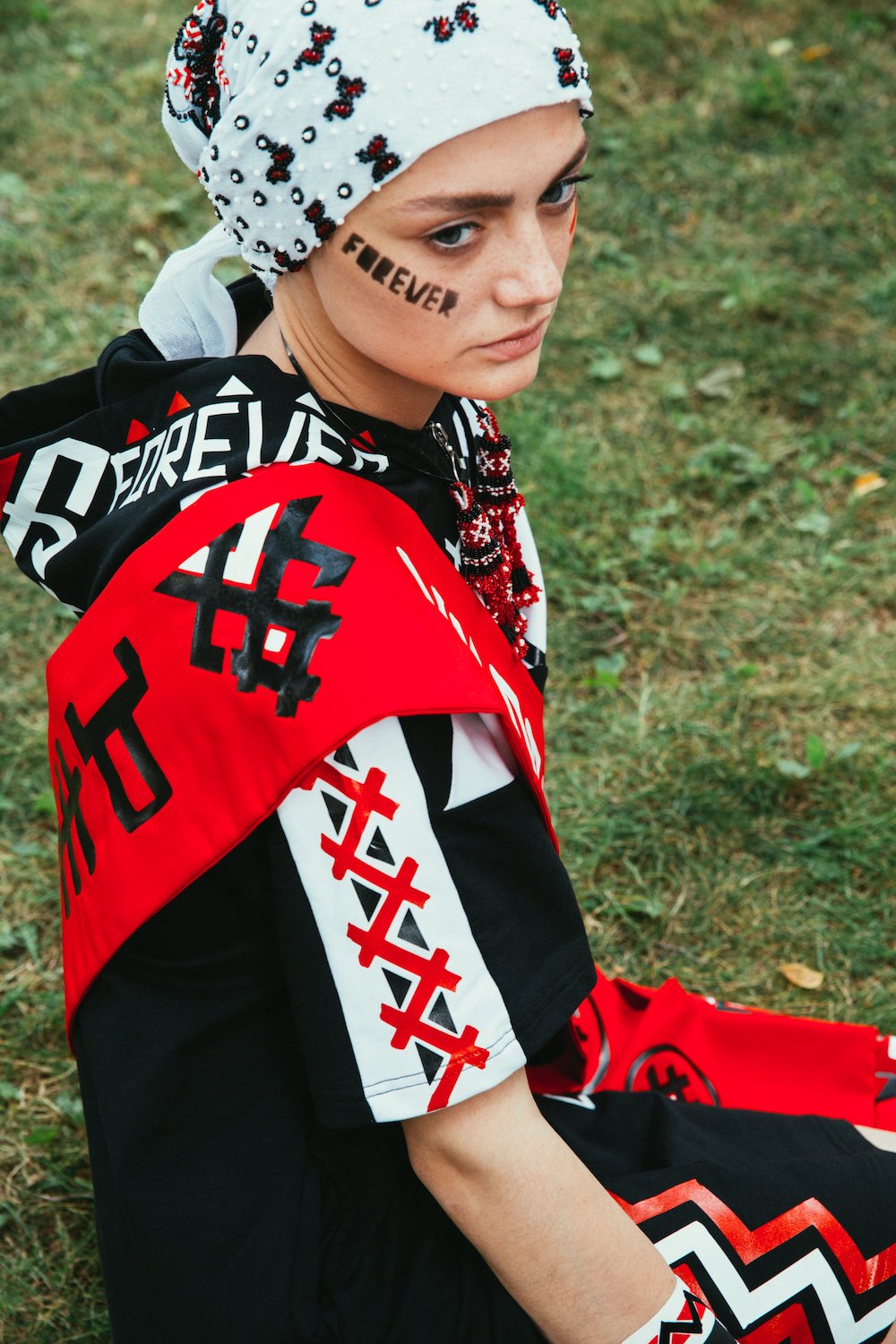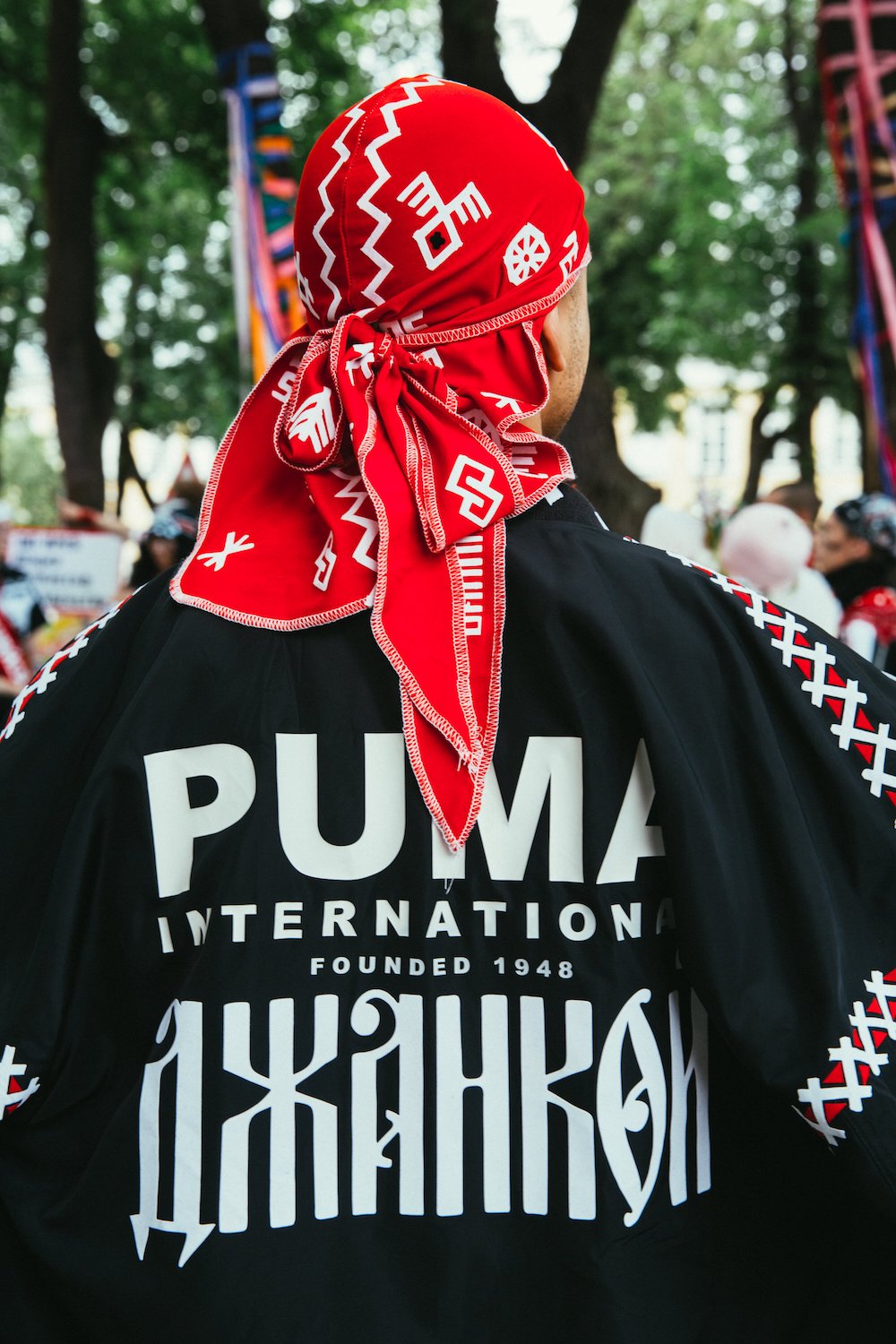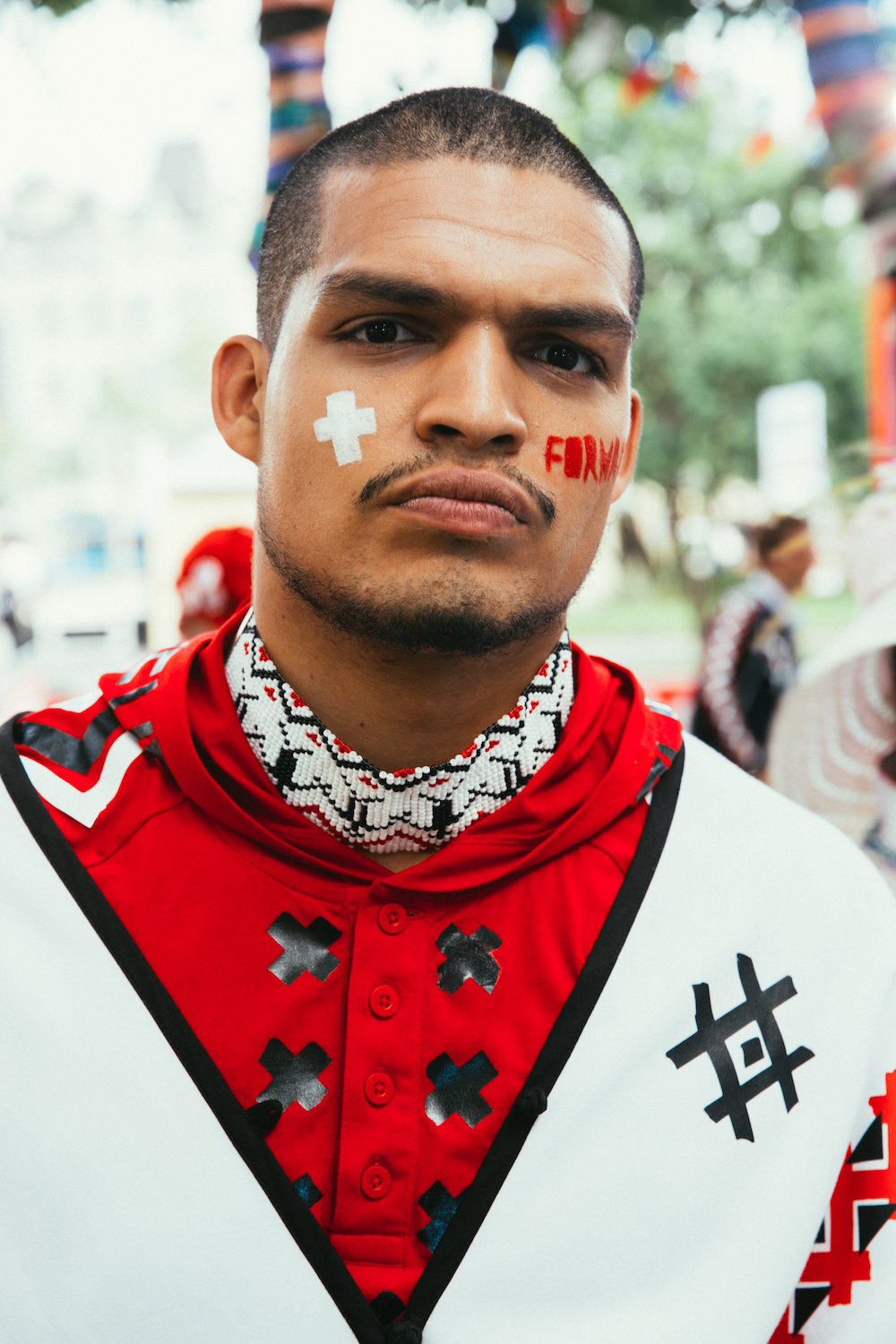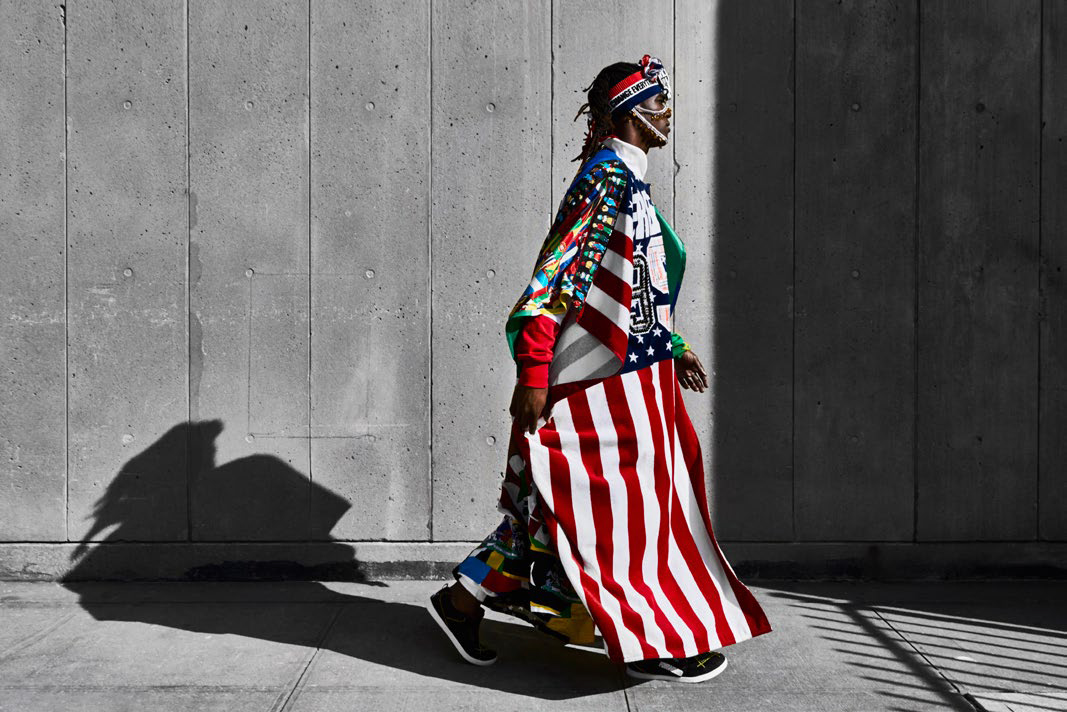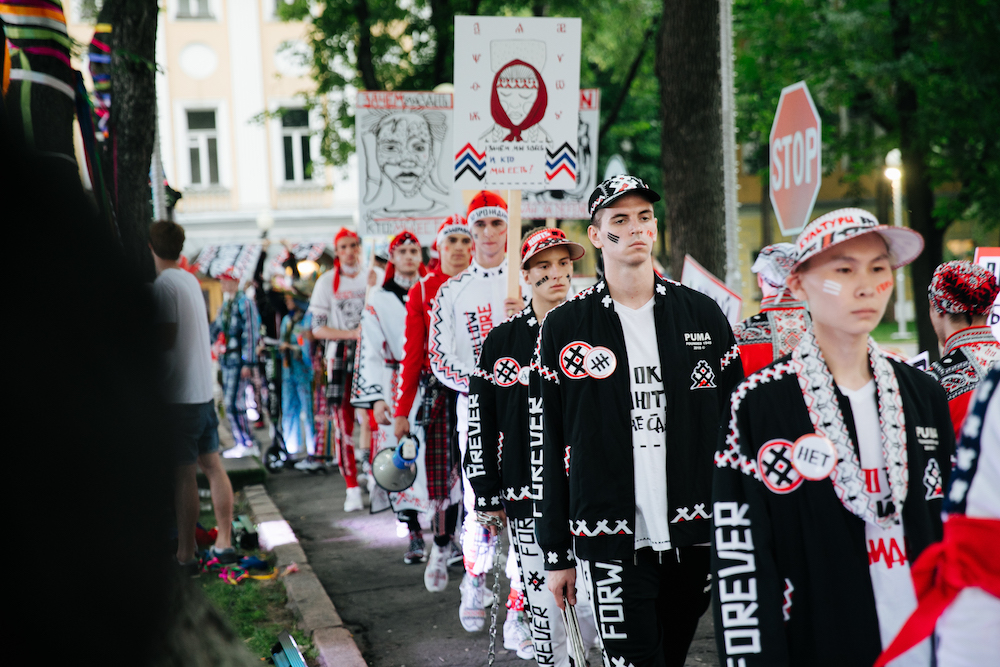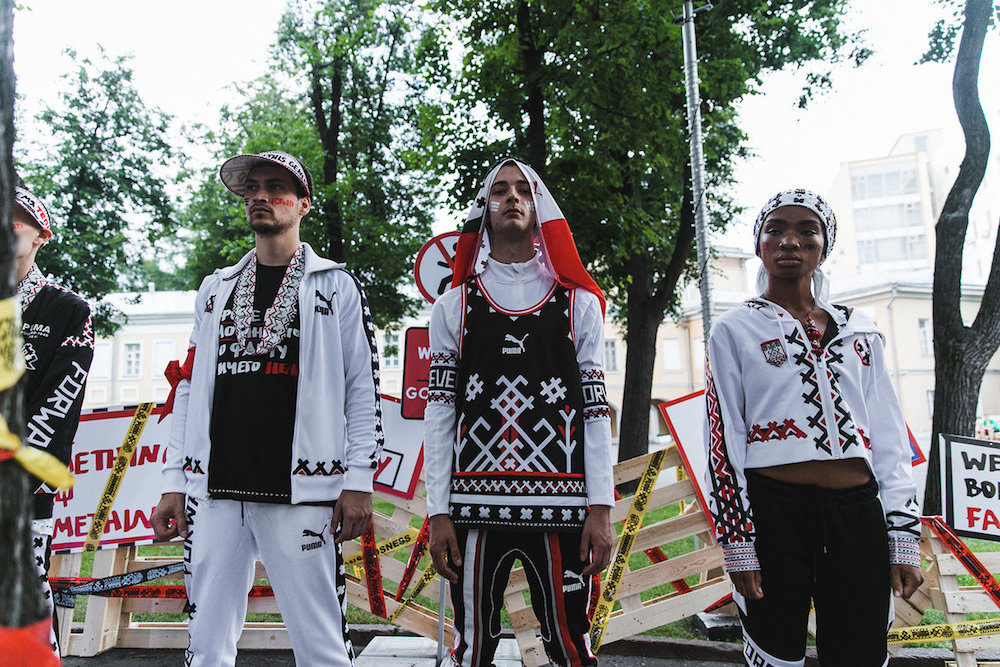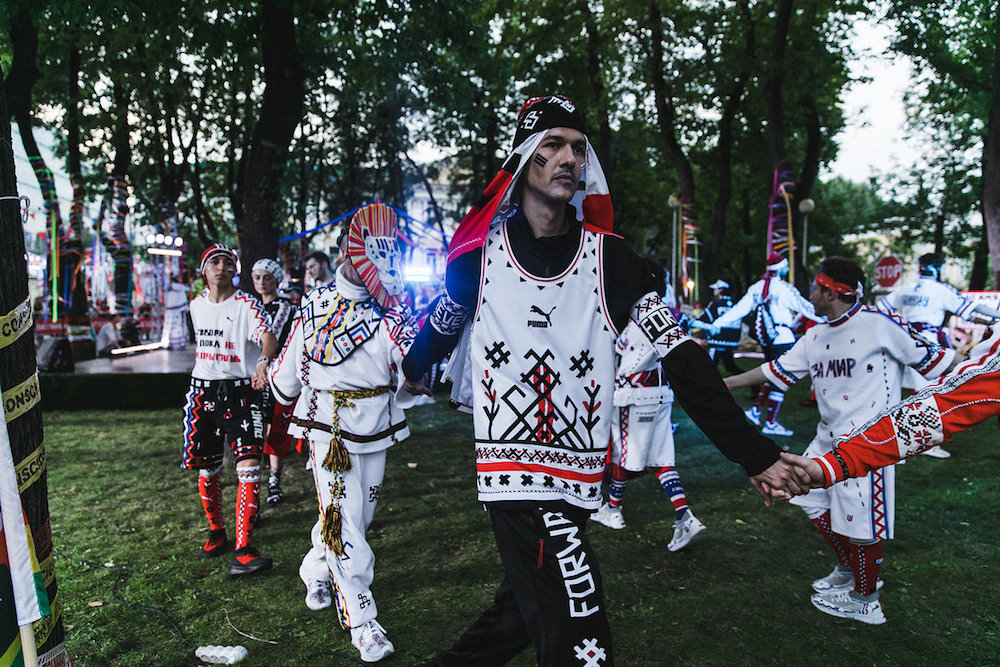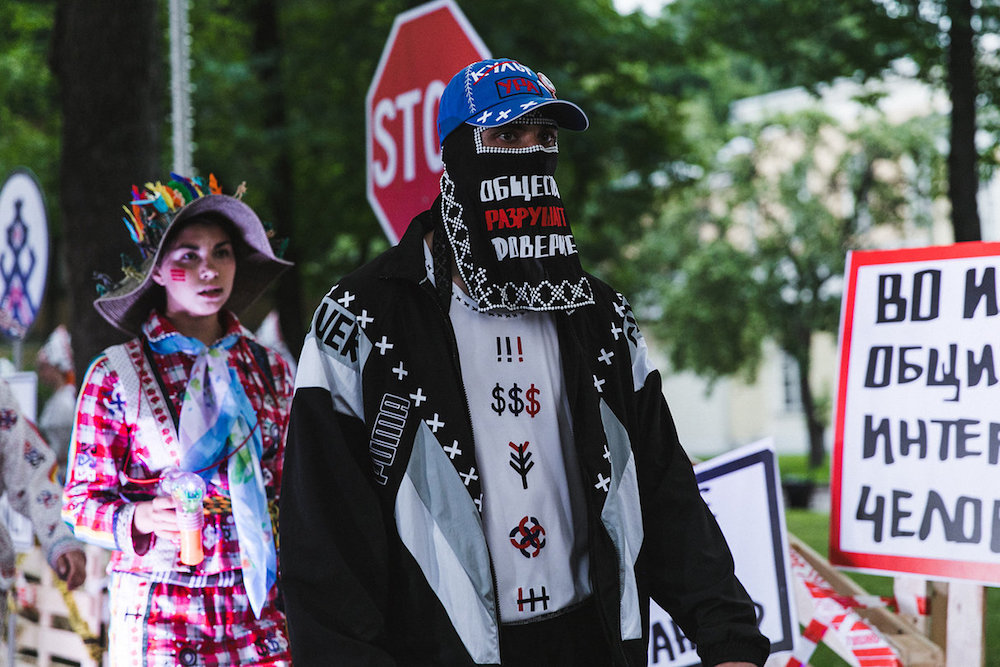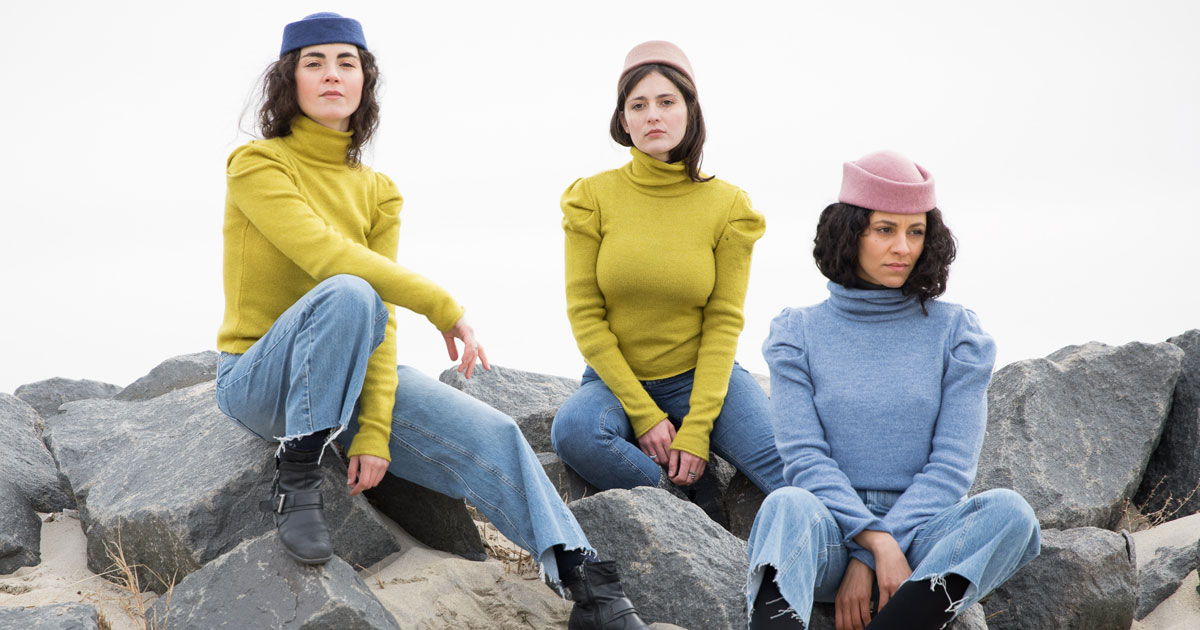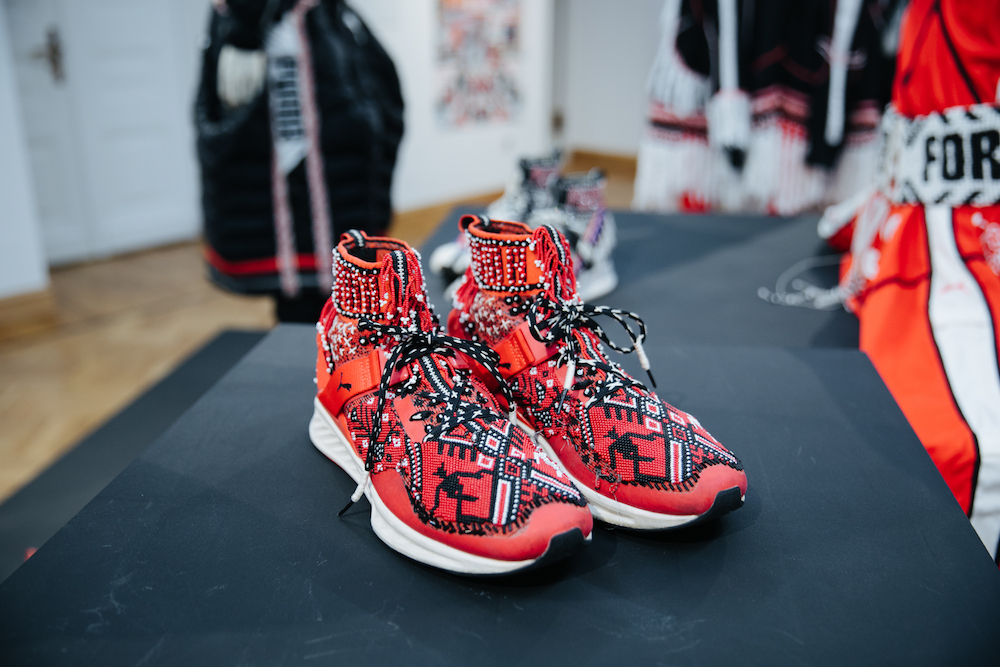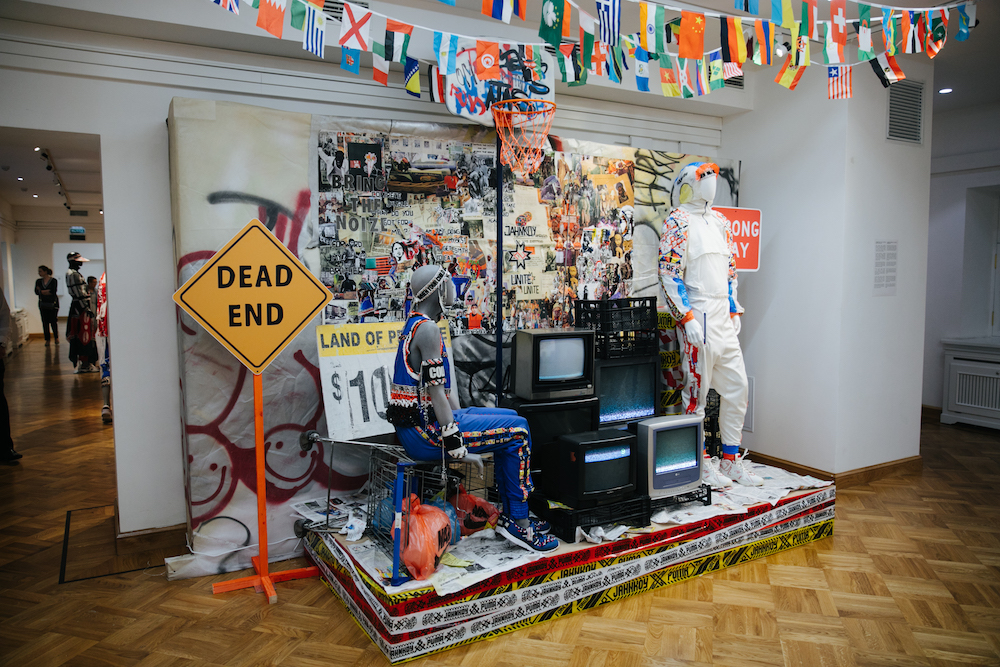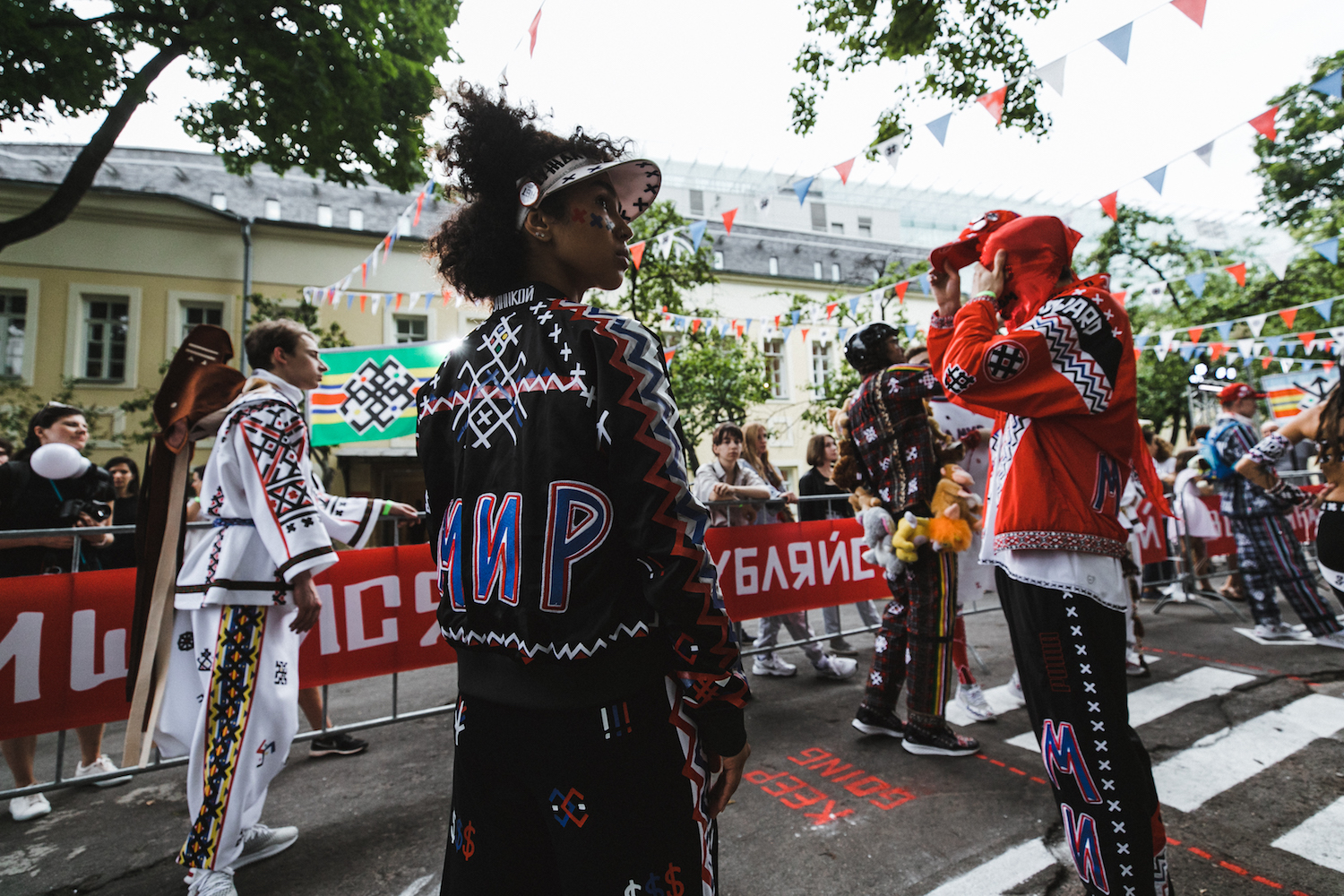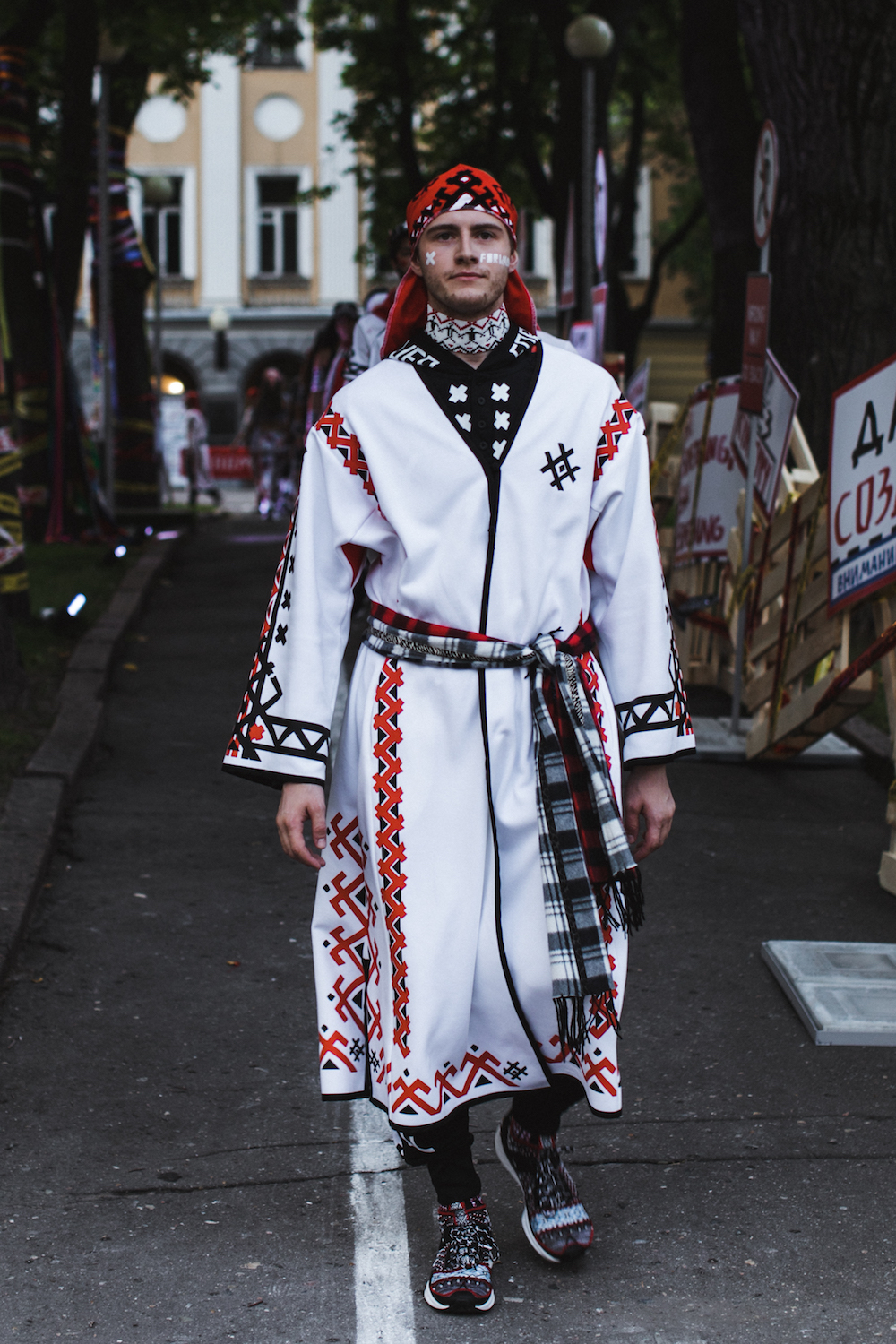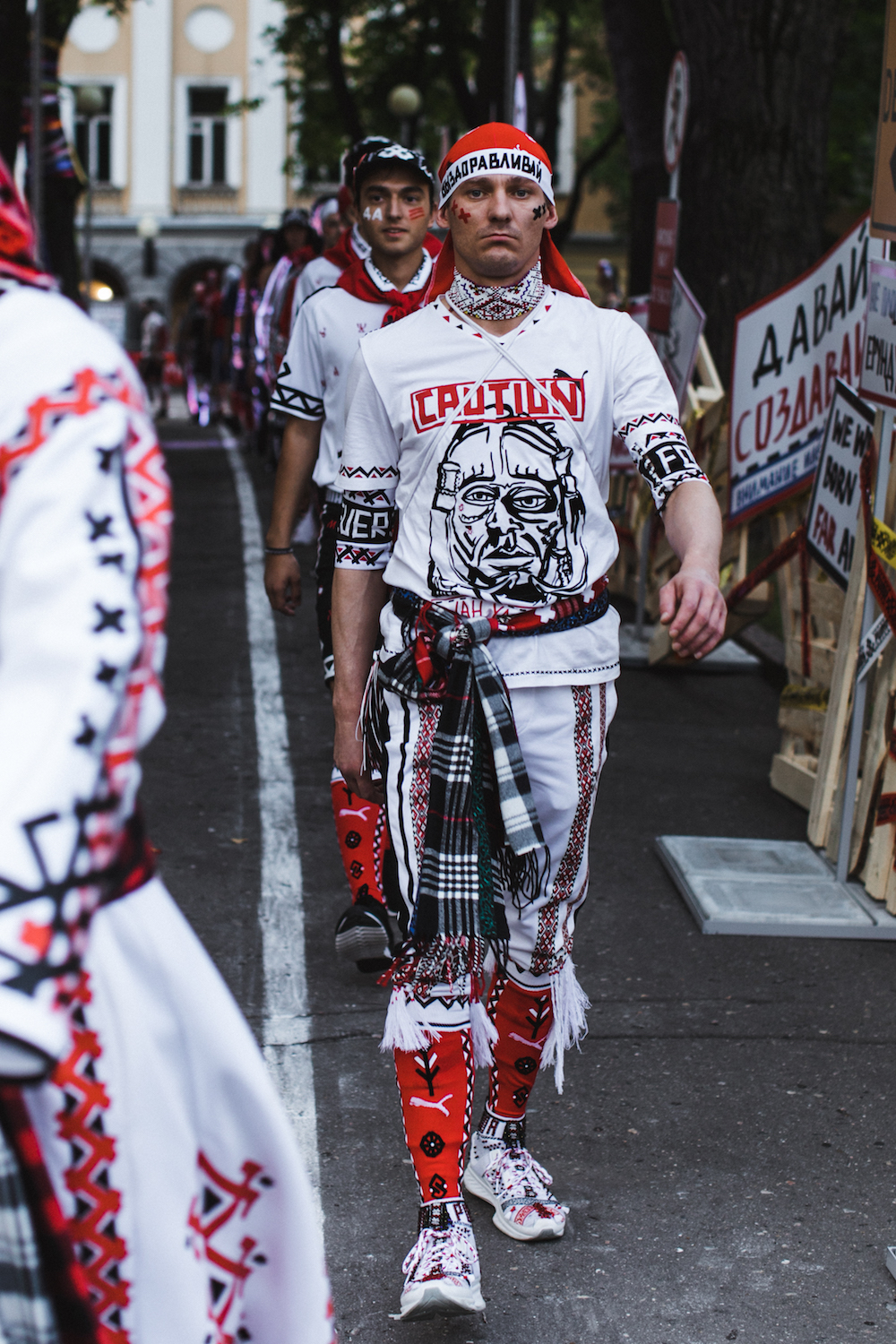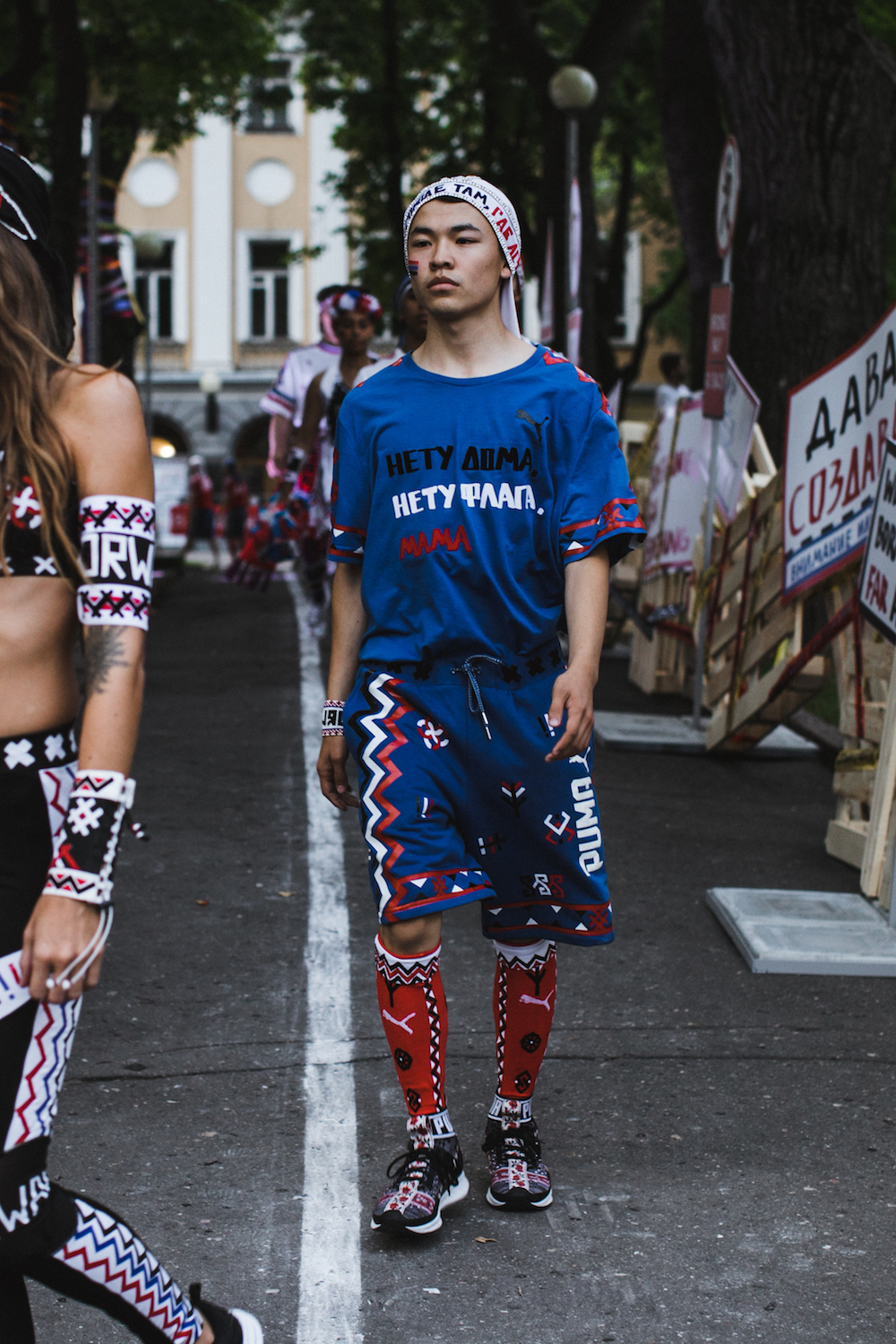Cultural appreciation: Jahnkoy is driving a hybrid global style that we can all get behind
New York label Jahnkoy draws its inspiration from a patchwork of influences: from environmental issues, Russian artisanal tradition, and founder Maria Kazakova’s Crown Heights neighbourhood. Here, Kazakova talks about 90s Russia and hybrid fashion in the age of cultural appropriation
On a hot midsummer day in Moscow, the courtyard of the All-Russian Museum of Applied Arts looks like an enchanted forest. Hundreds of colourful ribbons hang from tree branches. Decorated with traditional Russian emroidery and the words “Jahnkoy” and “Puma”, others are styled to resemble the police “do not cross” yellow tape. For two weeks, this quiet museum, usually popular among senior citizens and school groups, is hosting an exhibition of the New York-based label Jahnkoy and its tribal, planet-conscious futurism.
Jahnkoy: Deceived No More welcomes the visitor with leftovers of globalisation: a bunch of old TVs shimmering with white noise, a wall of graffiti and a vibrant assemblage of plastic bags. Among them, the garments displayed on two mannequins look like ordinary sportswear, but a closer look reveals that the brightly-coloured pattern on sleeves and trainers is actually the intricate work of beading, weaving and embroidery. If sportswear is a symbol of globalisation, the reference to traditional crafts is a comment on the world, post-globalisation — the patterns are woven using multicoloured plastic threads, the same material which litters every foot of coastline around the world.
Jahnkoy first appeared on the cultural radar after making it into the 2017 LVMH Prize shortlist. The collection, titled Displaced, drew on fast fashion and its catastrophic effects — “the donations of Western clothes to the African continent, and the way it brings destruction to artisanal crafts, tradition and culture”. Some critics were surprised to trace the creative path of Jahnkoy’s founder and designer Maria Kazakova to Russia. Born in Novosibirsk’s Akademgorodok, Kazakova lived in Abakan in the Siberian region of Khakassia and Moscow, before moving to London to study at Central Saint Martins and eventually New York to attend Parsons School of Design. If Jahnkoy was born in NYC’s diverse melting pot, the latest collection, titled Deceived No More aka Born to Appropriate is a kind of homecoming for Kazakova.
“I was trying to understand the things which I grew up with, but also questioning why and how we lose traditional culture in Russia,” Kazakova explains. “I divided the collection into tribe-like groups. The City group is based on contemporary trends and things I grew up with, like hip-hop, dancehall, football and other sports, Disney, cartoon animals and plastic guns. The Messenger group is all red, black and white and is based on the visuals of communism and the Russian Revolution, and the message of global unity. The last group is Lost Cultures, for which I drew on traditional cultures like traditional folk costumes.”
Born in 1988, Kazakova grew up during the turbulent 1990s, when an avalanche of Western pop culture and cheap Chinese goods completely transformed the post-Soviet cultural landscape. In recent years, the decade has been a source of inspiration for many designers, including the cutting-edge Russian youth culture pioneer Gosha Rubchinskiy. The result has always been fairly homogenous, relying solely on sportswear. Kazakova, by contrast, delves deeper and brings up something much more complex and strange: wild futurism in a patchwork of folklore and global iconography, like Ivan Bilibin’s fairy tales on acid.
“As a child, I rememeber standing in line for goods and always talking to people in the queue. Visually, everyone was dressed in very plain clothes but I always wanted something different. I remember once my stepfather brought me a Japanese magazine with street fashion photographs, and it was complete craziness. I could feel my world expanding. I thought wow, this is possible, people actually dress like this!” Kazakova recalls. “When I was a teenager, my aunt brought me pink Levi’s jeans from America, they were huge, and I would wear them low and baggy because I was obsessed with Eminem and 2pac. My underwear was showing. Imagine that, pink jeans with green underwear.”
Kazakova’s fascination with crafts started with the National Geographic magazine, which fed her curiosity about the world and cultures outside of Russia. “I never got into the pop culture that most people were into, so I spent my time reading about the world.” She remembers being perplexed by the absence of tradition in everyday wear. “In Khakassia I went to a museum and saw beautiful traditional clothes. I come out in the street and everyone is wearing fake Adidas. We had a big market for cheap clothes from China and Turkey and lots of second-hand clothes from West, and that was it. On the other hand there was this beautiful heritage in the museum, and even the museum store doesn’t have a copy of this.”
As a teenager, Kazakova got into reggae music, which she cites as one of her formative influences. For her, clothing is clearly a language which incorporates all these elements: the day we meet, Kazakova is wearing a long floral dress, an abundance of jewellery and massive silver rings, a scarf over her hair and black lipstick. On a few occasions more recently, Kazakova has been spotted wearing a kokoshnik, a traditional Russian crest-shaped headdress. On the streets of Moscow, among people dressed largely in mass-produced clothes, Kazakova looks like a gypsy futurist or a shaman of some otherworldly nation.
Overall, the ethos of Jahnkoy relies on two key notions: drawing much-needed attention to the state of global fashion and its impact on the world, and the political meaning of craftsmanship. In a world dominated by fast fashion, Kazakova is trying to educate people about the importance of investing time and labour into garments — why buying a $5 T-shirt in London or Berlin will inevitably have an impact on the other side of the world. Kazakova currently produces everything in Brooklyn, with aims to outsource parts of the beadwork to India in the near future.
Jahnkoy is a fresh example of contemporary hybrid identity: its combination of crystals, plastic bags, soda cans, feathers, Puma logos and intricate embroidery are shaped by immigrant cultures and an intercontinental, digitally-enabled exchange of information. But hybrid identity always brings with it the question of cultural appropriation. There is a long history of black culture being mined for profit by white creatives, from Kim Kardashian’s cornrow controversy to Yves Saint Laurent (YSL) allegedly copying a clutch bag by an up-and-coming Senegalese brand. In this light, Kazakova often has to justify her interest in cultures seemingly so distant from her own. During her studies in London, her tutor encouraged her to try her hand at menswear and at the same time she began researching Carribean culture. “He would always ask me: why?”
“At Parsons, all my school work wrestled with whether I have a right to talk about or research black culture. But my education was divided between the streets and school, I would go out and talk to people and then bring this material to my studio,” Kazakova remembers. “If I live in Crown Heights I’m part of Crown Heights. I talk like them, I walk like them. Yes, we don’t share the same upbringing or face the same issues, but I could relate to it, understand it and maybe do something to bring attention to it. Or otherwise I can just say, look, I have white skin, I come from Russia, all my clothes will be Russian, all my models will be Russian, and then no one else but Russians can wear it — it’s impossible!”
Kazakova’s work for Jahnkoy poses questions which are incredibly relevant for contemporary fashion. It speaks about the value of research, knowledge and community in one’s creative output. It fosters artisinal crafts, while still staying modern. It celebrates the free flow of ideas, signs and meanings yet questions the nature of fashion as a fast and merciless appropriation machine which repurposes everything while discarding its context. That might be why Jahnkoy is different: it’s deeply rooted in its context. Be it Russian heritage or her neighbourhood of Crown Heights, Kazakova also speaks of consumers’ choices we make and how they define us.
“Is it a problem that Gucci made its own version of a traditional Russian kokoshnik?” she asks. “I think the main question is the choice you make: you can either buy it from Gucci or go to the village and buy the real thing.”
Text: Anastasiia Fedorova
Image: Valera Belobeev, Dima Konkov, Julia Mayorova
